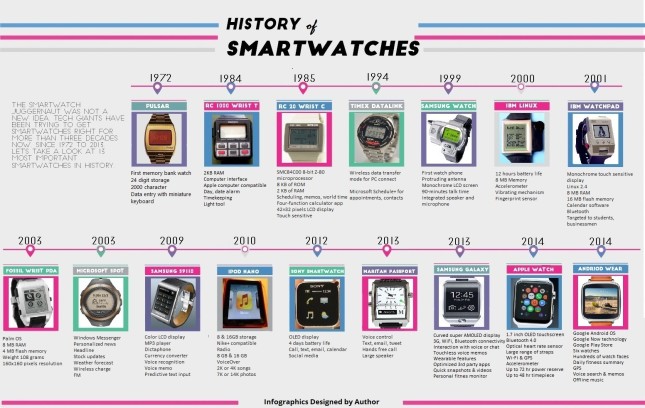While demand for PC and tablet is reaching an equilibrium and smartwatch uptake is accelerating, technology companies are racing to develop smartwatches as they hope to see the market royally takes off in 2015. According to a US Consumer Technology Association (CEA) forecast, 10.8 million smartwatches will be sold in US alone this year. That’s a whopping 359% increase over 2014. CCS Insight’s global wearable forecast predicts that wearables will grow from modest 29 million in 2014 to 75 million by 2015 and subsequently 178 million by 2018.
The mainstreaming of smartphones in both consumer and enterprise space will revolutionize the way we live, work and communicate. Applications in sports, healthcare and medicine, entertainment, retail and manufacturing are enabling the wearable future for potential improvement in productivity, communication, efficiency, entertainment, connectivity, health, wellness and beyond.
Endless possibilities
Possibilities are endless across domains and apps; however, as per a CEA research the most important smartwatch features are fitness-focused. The study found that health monitoring (91%), peak performance monitoring (90%) and workout routines (82%) are most desired. This trend is not just a fad. It is transforming the way consumers and enterprises look at healthcare and wellness. From fitness apps that monitor health movements during the day to monitoring of essential aspects of vital signs like body temperature, heart rate variability, hydration level etc.; smartwatches are helping consumers recognize patterns with easy to use advanced insights. Easy, intelligent biometric monitoring and tracking are enabling more convenience and value additions. Monitoring activities could lead to better diet and exercise accountability, improved access to medical information, higher clinical trial participation and more accurate diagnosis. All in all, it helps patients take better care of their health. It also aids healthcare practitioners to keep abreast of changes without several appointments. On an average, a primary care physician cannot allocate more than 20 minutes to a patient, and in that time, she has to gather basic patient health related data like cholesterol levels, blood pressure and assume general lifestyle dynamics. On the contrary, a smartwatch which gathers real time information can produce a nice neat little report to let doctors have a 360 degree comprehensive overview and aid them act with more precision.
The generated patient data coupled with analytics can open a floodgate of opportunities for healthcare organizations. Healthcare systems are experiencing ageing population, chronic illness (75% healthcare costs are linked to chronic conditions) and highly expensive treatments across ever increasing treatment options. By leveraging systems such as remote control monitoring, healthcare organizations can potentially reduce costs to a great extent. Medical wearable technology which is still at its nascent stage can help fill the gaps in electronic health records. With the available data, Insurers and employers can manage costs and deploy tailored health programs for different demographics. Pharma and life science companies can run dynamic clinical trials and transform data into outcome based reimbursements.
Healthcare is hot
No wonder, the potential is fuelling the healthcare sector. For investors and technology companies, key focus for 2015 is healthcare as it reinforces increased collaboration, connectivity and focus. Healthcare stocks were one of the two best performers across all US stock exchanges last year. In the investment space, digital health funding surpassed $4.1 billion in 2014, nearly the total of all three prior years combined, and represented 124% year over year (YoY) growth. The industry it seems is strategically ripe for all kinds of players and everyone is seeking a pie in the next big thing. Traditional healthcare companies like GE, Blue Cross/Blue Shield of Florida or CVS are investing heavily in multiple new age healthcare startups to take on their saturating forecast in established domains. GE’s February 2014 announcement of investing $1.5 billion into industrial internet research means it is damn serious about taking the next giant leap into the world of industrial wearable technology. New age technology giants like Google and Apple are injecting mammoth resources. So much so that Google has parked one third of its investable dollars in healthcare and life science companies, up from 9% each of the prior two years, reports Wall Street Journal. Google, Apple, Microsoft, Cisco, Oracle together believed to have $245 billion as investable cash reserve. Irrespective of the maturity, R&D and progress, they all are immensely keen in wearable technologies, IoT and IoP. Intel has partnered with traditional watch brands like Fossil, Oakley and Tag Heuer to propel its smartwatch footprint. Acrons, an investment app has closed two series of funding of $10.5 and $23 millions. Jawborne, notwithstanding a setback last year completed a new round of funding to the tune of $300 million from Blackrock.

